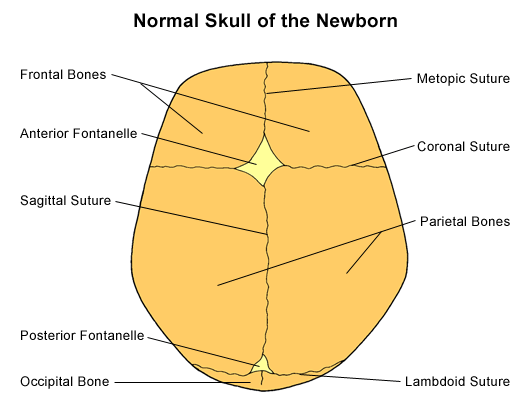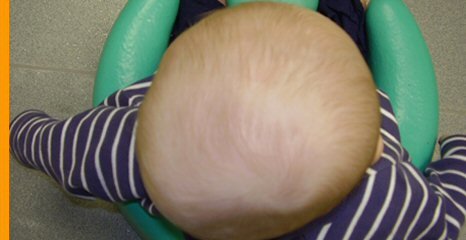with thanks to Dr Harriet Clompus.
Assessment of fontanelles is an important part of the six week check. Large fontanelles may indicate a problem in bone ossification or hydrocephaly, while a fused anterior fontanelle can indicate craniosynostosis. These need to be referred to paediatric outpatients. Always remember that anterior fontanelle size is very variable (1-4.7 cm in any direction) and always needs to be assessed in context of baby’s head circumference.
A sunken fontanelle indicates dehydration, while a bulging fontanelle indicates raised intracranial pressure (but can be non-pathological – vomiting, crying, coughing – so assess when baby settled!). These can be discussed with paediatric registrar on-call.
1) The anterior fontanelle is diamond shaped, 1-4.7 cm in any direction at birth (black infants larger than white) and can widen in first 2 months of life. Median age of closure is 14 months (4 – 24 months)
2) The posterior fontanelle is triangular and is less than 1 cm. It closes by 6 – 12 weeks.
3) The size of the fontanelles should always be assessed in conjunction with the head circumference.
- Macrocephaly – familial, hydrocephaly or skeletal disorders such as achondroplasia.
- Microcephaly – familial, congenital infections, fetal alcohol syndrome, trisomies
4) The quality of the fontanelle should always be assessed.
- Soft fontanelle – normal
- Bulging fontanelle – raised intracranial pressure (hydrocephalus, meningitis/encephalitis) . NB can be non-pathological in crying, coughing or vomiting infant.
- Sunken fontanelle – dehydration
1) WIDENED FONTANELLES: think of…
Achondroplasia
Downs
Hydrocephalus
IUGR
Prematurity
Congenital Rubella
Neonatal Hypothyroidism (3rd fontanelle)
Osteogenesis Imperfecta
Malnutrition
Rickets/Osteomalacia
Rickets – Think of rickets in darker skinned, breast fed babies, especially if mothers are veiled. Infants will often have sweating on the head. If widened sutures are found check neonatal blood spot for hypothyroidism and refer to outpatients.
Hydrocephalus – can have widened, bulging fontanelles in conjunction with a large head.
2) PREMATURE FUSION OF FONTANELLES AND CRANIOSYNOSTOSIS
Closure of anterior fontanelle by six weeks always pathological (NB by 3 months 1% of normal infants will have a closed anterior fontanelle).
Must always assess in conjunction with head circumference – early fusion associated with microcephaly (and less commonly, macrocephaly).
Craniosyntosis is premature closure of cranial suture(s) with skull growth restriction perpendicular to fused suture and compensatory skull overgrowth in unrestricted areas. Presents with ridging (always pathological beyond one week of life) and abnormal skull shape (usually later than six weeks).
There is a nice background overview (with useful diagrams) to craniosynostosis at http://www.cincinnatichildrens.org/health/info/neurology/diagnose/craniosynostosis.htm.
Primary craniosynostosis is due to abnormal ossification of one or more sutures. Simple – premature fusion of one suture, complex – premature fusion of multiple sutures. Causes include rickets, hyperparathyroidism, hyperthyroidism , idiopathic and genetic causes such as Aperts.
Secondary craniosynostosis is caused by premature closure of ALL sutures due to lack of primary brain growth. If you find a child with premature closure of fontanelles or over-riding sutures at six week check you should refer to paediatric outpatients. NB Plagiocephaly (flat occiput) is a non-pathological deformation due to ‘back to sleep’ position – no action required. It presents with ear on flattened side presenting anteriorly. Parallelogram shaped head (as opposed to lambdoid suture craniosynostosis trapezoid shaped)
The following articles give lots of information on fontanelles and/or sutures. The Fuloria article is very thorough and although it focuses on neonatal examination, most of it is still relevant for the six week check.
1) The Abnormal Fontanel, J KIESLER et al Am Fam Physician. 2003 Jun 15;67(12):2547-2552. http://www.aafp.org/afp/2003/0615/.html (figure 2 taken from abnormal fontanel)
2)The Newborn Examination: Part I. Emergencies and Common Abnormalities Involving the Skin, Head, Neck, Chest, and Respiratory and Cardiovascular Systems, Fuloria et al, Am Fam Physician. 2002 Jan 1;65(1):61-69. http://www.aafp.org/afp/2002/0101/p61.html
3) http://www.nice.org/CG037quickrefguide
4) http://www.patient.co.uk/doctor/Examination-of-the-Neonate.htm
5) Craniosynostosis, P Raj et al, emedicine jul 2010 Craniosynostosis : eMedicine Neurology

